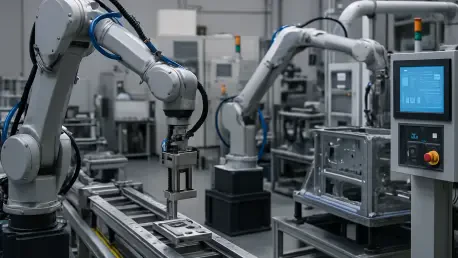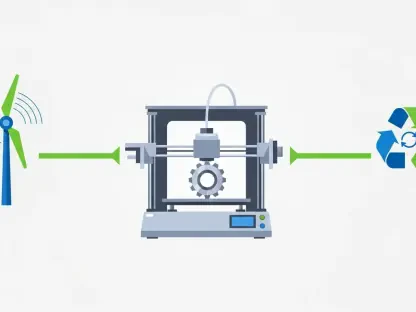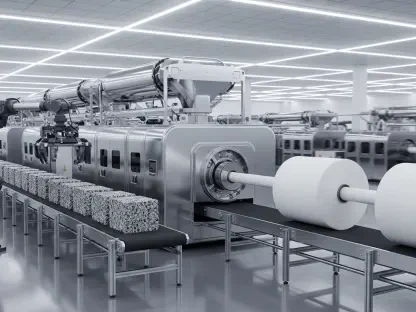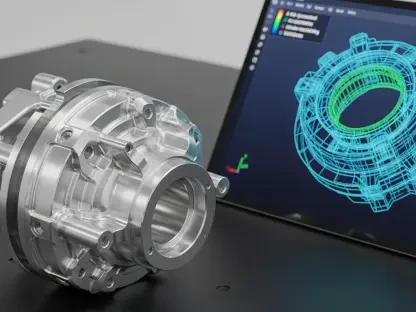In an era where technological advancements are reshaping industries at an unprecedented pace, the manufacturing sector stands at a critical juncture, grappling with the transformative potential of smart factories. The promise of enhanced productivity and efficiency through digital innovation is compelling, yet the path to realizing these benefits is complex and demands a calculated approach. Recent studies reveal that companies embracing smart manufacturing technologies have reported significant gains, with some achieving up to a 20 percent boost in production output. This statistic underscores the urgent need for manufacturers to adapt or risk falling behind in a highly competitive landscape. As the industry navigates this shift, the focus must be on overcoming inherent challenges and aligning investments with long-term business goals to ensure sustainable success.
Unlocking the Potential of Smart Factories
Driving Productivity Through Technology Adoption
The adoption of smart manufacturing technologies has proven to be a game-changer for many enterprises, setting a new benchmark for operational efficiency. A notable increase in productivity, often by as much as 20 percent, has been observed among companies that have integrated advanced tools into their production processes. This surge not only enhances output but also empowers employees to work more effectively, addressing the ever-growing demands of the market. The competitive edge gained by early adopters highlights the transformative impact of smart factories, positioning them as leaders in an industry where agility is paramount. However, the journey is not without obstacles, as firms must contend with operational risks and the need for robust systems to support these innovations. The evidence suggests that while the rewards are substantial, a deep understanding of technological integration is essential to maximize benefits and maintain a stronghold in the evolving manufacturing arena.
Investment Priorities for Future Growth
Looking ahead, manufacturers are setting ambitious investment priorities to bolster their capabilities over the next two years, from now until 2027. Process automation tops the list, with 46 percent of industry leaders identifying it as a critical focus, followed closely by physical automation at 37 percent and advanced production scheduling at 35 percent. Other key areas include factory synchronization, execution systems, and quality management, each representing a significant portion of planned expenditures. These strategic investments aim to tackle persistent challenges such as skilled labor shortages and material constraints while optimizing overall productivity. The emphasis on automation and synchronization reflects a broader industry trend toward creating interconnected, efficient systems that can adapt to dynamic market needs. As companies allocate resources to these areas, the focus remains on building a resilient foundation that can support sustained growth and innovation in an increasingly digital landscape.
Navigating Challenges in Implementation
Addressing Workforce and Cybersecurity Concerns
As smart manufacturing reshapes the industry, one of the most pressing challenges lies in preparing the workforce for a technology-driven future. Approximately 35 percent of manufacturers express concern over the need to upskill employees to effectively collaborate with advanced tools like artificial intelligence. This shift in the nature of work demands comprehensive training programs and change management strategies to ensure seamless integration of human and machine efforts. Beyond talent development, cybersecurity emerges as a critical hurdle, with the increasing connectivity of smart factories heightening vulnerability to digital threats. Protecting sensitive data and operational systems is paramount, requiring robust security frameworks to safeguard against potential breaches. The dual focus on workforce readiness and cybersecurity underscores the multifaceted nature of implementing smart technologies, where success hinges on addressing both human and technical dimensions with equal rigor.
Strategic Alignment for Effective Execution
Effective implementation of smart manufacturing goes beyond mere technology adoption; it requires deliberate alignment with overarching business strategies. Industry experts emphasize the importance of establishing dedicated teams to oversee the extensive changes in processes and operations that accompany digital transformation. Such teams play a pivotal role in mitigating risks and ensuring that technological investments translate into tangible outcomes. The complexity of this transition necessitates a clear vision and committed execution, as missteps can undermine even the most promising initiatives. By prioritizing strategic planning, manufacturers can navigate the intricate landscape of smart factory adoption, balancing innovation with operational stability. This approach not only addresses immediate challenges but also lays the groundwork for long-term competitiveness, reflecting a nuanced understanding of how focused execution can turn technological potential into measurable success.
Reflecting on Transformative Steps Forward
In looking back at the strides made in smart manufacturing, it becomes evident that the industry has reached a turning point where strategic implementation is no longer optional but essential. The remarkable productivity gains witnessed by early adopters serve as a testament to the power of smart technologies when harnessed effectively. Challenges like workforce upskilling and cybersecurity have been met with innovative training solutions and fortified digital defenses, paving the way for more resilient operations. As manufacturers chart their next moves, the focus shifts toward deepening investments in automation and data-driven tools to sustain momentum. The journey highlights the value of aligning technological advancements with business objectives, ensuring that every step taken is purposeful. Moving forward, the industry must continue to prioritize adaptable strategies and collaborative efforts to address emerging complexities, setting a robust foundation for future innovations and enduring growth in a dynamic global market.









